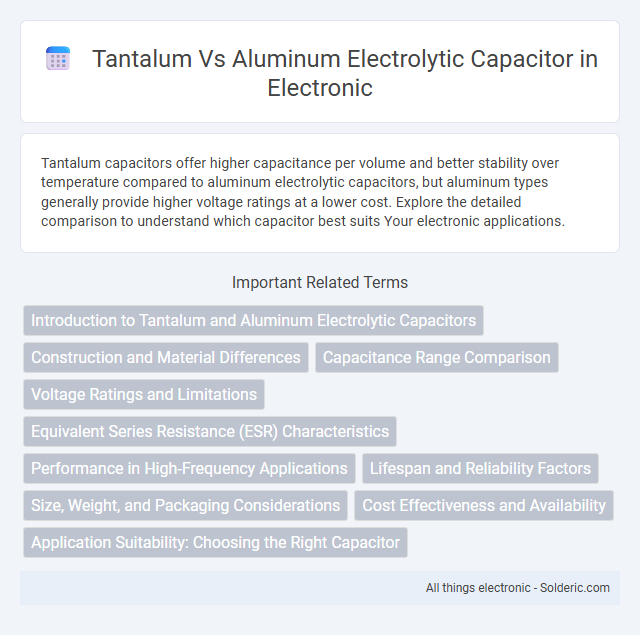Tantalum capacitors offer higher capacitance per volume and better stability over temperature compared to aluminum electrolytic capacitors, but aluminum types generally provide higher voltage ratings at a lower cost. Explore the detailed comparison to understand which capacitor best suits Your electronic applications.
Comparison Table
| Feature | Tantalum Electrolytic Capacitor | Aluminum Electrolytic Capacitor |
|---|---|---|
| Capacitance Range | 0.1 uF to 470 uF | 1 uF to 1,000,000 uF |
| Voltage Range | 2 V to 50 V | 6.3 V to 500 V |
| ESR (Equivalent Series Resistance) | Low ESR | Higher ESR compared to tantalum |
| Size | Compact, smaller volume | Larger size for same capacitance |
| Reliability | High stability, sensitive to voltage spikes | Good stability, tolerant to voltage spikes |
| Cost | Higher cost | Lower cost |
| Applications | Precision circuits, filtering, timing | Power supplies, audio equipment, bulk storage |
| Polarization | Polarized | Polarized |
Introduction to Tantalum and Aluminum Electrolytic Capacitors
Tantalum and aluminum electrolytic capacitors serve as essential components in electronic circuits, each with distinct characteristics and applications. Tantalum capacitors offer stable capacitance, high volumetric efficiency, and excellent performance in low-voltage applications, making them ideal for filtering and decoupling tasks in compact devices. Aluminum electrolytic capacitors provide higher capacitance values and better handling of surge currents, suited for power supply filtering and energy storage, but generally have larger sizes compared to tantalum capacitors.
Construction and Material Differences
Tantalum electrolytic capacitors use a tantalum metal anode coated with a thin layer of tantalum pentoxide, providing a stable and high-capacitance dielectric. Aluminum electrolytic capacitors feature an aluminum foil anode covered with aluminum oxide as the dielectric layer, resulting in lower cost but larger physical size. Your choice depends on the need for higher reliability and energy density (tantalum) versus cost-effectiveness and volume (aluminum).
Capacitance Range Comparison
Tantalum electrolytic capacitors typically offer capacitance values ranging from 0.1 uF to 470 uF, making them suitable for low-to-medium capacitance applications with stable electrical performance. Aluminum electrolytic capacitors provide a broader capacitance range, from 1 uF up to several thousand microfarads, ideal for high capacitance requirements in power supply filtering. The choice between tantalum and aluminum capacitors depends on the capacitance needs, with aluminum capacitors preferred for higher capacitance and tantalum capacitors favored for smaller, more stable capacitance values.
Voltage Ratings and Limitations
Tantalum electrolytic capacitors offer higher voltage ratings in a smaller size compared to aluminum electrolytic capacitors, making them ideal for compact, high-performance circuits. However, tantalum capacitors have strict voltage limitations and can fail catastrophically if exposed to voltages beyond their ratings. When selecting capacitors for your design, choosing aluminum electrolytic capacitors provides broader voltage tolerance and greater reliability in high-voltage applications.
Equivalent Series Resistance (ESR) Characteristics
Tantalum capacitors feature lower Equivalent Series Resistance (ESR) compared to aluminum electrolytic capacitors, resulting in better performance in high-frequency applications and improved efficiency. The stable ESR characteristic of tantalum capacitors contributes to reduced ripple voltage and enhanced reliability under thermal and electrical stress. Aluminum electrolytic capacitors generally exhibit higher ESR, which can lead to increased heat generation and reduced lifespan in demanding circuits.
Performance in High-Frequency Applications
Tantalum electrolytic capacitors exhibit superior performance in high-frequency applications due to their low equivalent series resistance (ESR) and stable capacitance over a wide frequency range. Aluminum electrolytic capacitors typically have higher ESR and inductance, which limits their effectiveness at high frequencies and results in greater signal loss. Consequently, tantalum capacitors are preferred for RF circuits and high-frequency filtering where signal integrity and efficiency are critical.
Lifespan and Reliability Factors
Tantalum capacitors offer a longer lifespan and higher reliability under stable voltage conditions due to their solid electrolyte and robust construction, making them ideal for applications requiring consistent performance over time. Aluminum electrolytic capacitors typically have a shorter lifespan influenced by electrolyte evaporation and are more susceptible to aging and temperature-related degradation. When designing your circuit, consider tantalum capacitors for enhanced durability and stability in environments demanding reliability and longevity.
Size, Weight, and Packaging Considerations
Tantalum electrolytic capacitors typically offer smaller size and lighter weight compared to aluminum electrolytic capacitors, making them ideal for compact electronic devices where space is limited. Your design benefits from tantalum capacitors' stable volumetric efficiency, allowing higher capacitance in a smaller package. Aluminum electrolytic capacitors, while bulkier and heavier, provide higher surge current capabilities and more diverse packaging options, suiting applications requiring robustness over compactness.
Cost Effectiveness and Availability
Aluminum electrolytic capacitors offer greater cost effectiveness due to their lower manufacturing expenses and widespread availability in various sizes and voltage ratings. Tantalum capacitors, while more expensive, provide higher performance in specific applications but are less readily available because of limited raw material sources. Your choice should weigh budget constraints against performance needs, considering that aluminum capacitors are generally more accessible and economical for mass production.
Application Suitability: Choosing the Right Capacitor
Tantalum capacitors offer high volumetric efficiency and stable electrical performance, making them ideal for applications demanding long-term reliability and low ESR, such as medical devices and aerospace electronics. Aluminum electrolytic capacitors excel in high capacitance and voltage requirements at a lower cost, suitable for power supply filtering and audio circuits where transient response is critical. Selecting between tantalum and aluminum electrolytic capacitors depends on balancing performance factors like size, capacitance, operating voltage, and environmental durability specific to the application's operational conditions.
tantalum vs aluminum electrolytic capacitor Infographic

 solderic.com
solderic.com